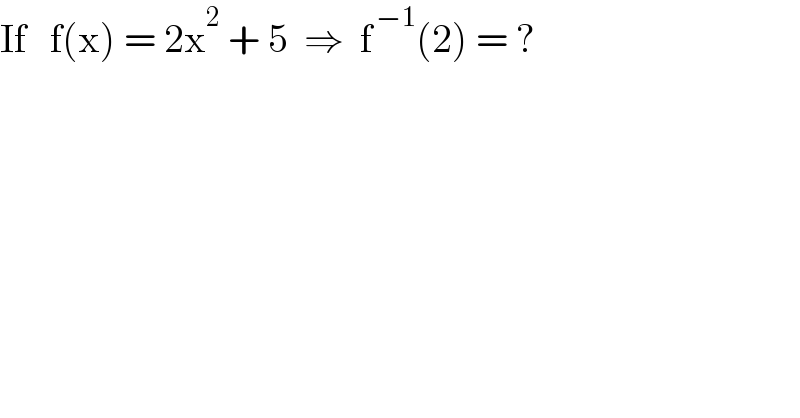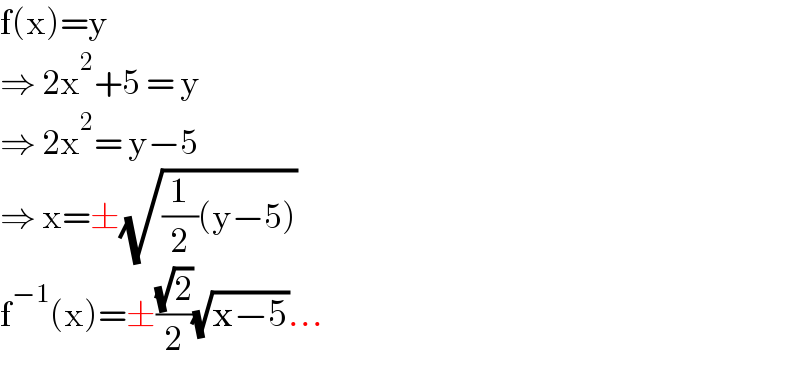
Question Number 150187 by mathdanisur last updated on 10/Aug/21

$$\mathrm{If}\:\:\:\mathrm{f}\left(\mathrm{x}\right)\:=\:\mathrm{2x}^{\mathrm{2}} \:+\:\mathrm{5}\:\:\Rightarrow\:\:\mathrm{f}^{\:−\mathrm{1}} \left(\mathrm{2}\right)\:=\:? \\ $$
Commented by amin96 last updated on 10/Aug/21

$$\mathrm{2}{x}^{\mathrm{2}} +\mathrm{5}=\mathrm{2}\:\:\Rightarrow\:\:\:{x}=\pm\frac{\mathrm{3}{i}}{\:\sqrt{\mathrm{2}}}\:\:\: \\ $$$${f}\left(\pm\frac{\mathrm{3}{i}}{\:\sqrt{\mathrm{2}}}\right)=\mathrm{2}\:\:\:\:\Rightarrow\:\:{f}^{−\mathrm{1}} \left(\mathrm{2}\right)=\pm\frac{\mathrm{3}{i}}{\:\sqrt{\mathrm{2}}} \\ $$
Answered by puissant last updated on 10/Aug/21

$$\mathrm{f}\left(\mathrm{x}\right)=\mathrm{y} \\ $$$$\Rightarrow\:\mathrm{2x}^{\mathrm{2}} +\mathrm{5}\:=\:\mathrm{y} \\ $$$$\Rightarrow\:\mathrm{2x}^{\mathrm{2}} =\:\mathrm{y}−\mathrm{5} \\ $$$$\Rightarrow\:\mathrm{x}=\pm\sqrt{\frac{\mathrm{1}}{\mathrm{2}}\left(\mathrm{y}−\mathrm{5}\right)} \\ $$$$\mathrm{f}^{−\mathrm{1}} \left(\mathrm{x}\right)=\pm\frac{\sqrt{\mathrm{2}}}{\mathrm{2}}\sqrt{\mathrm{x}−\mathrm{5}}... \\ $$
Commented by puissant last updated on 10/Aug/21

$$\mathrm{thank}\:\mathrm{you}\:\mathrm{sir} \\ $$
Commented by Rasheed.Sindhi last updated on 10/Aug/21

$${Perhaps}\:{there}'{s}\:{a}\:{typo}\:{sir} \\ $$$$\mathrm{x}=\pm\sqrt{\frac{\mathrm{1}}{\mathrm{2}}\left(\mathrm{y}−\mathrm{5}\right)}\Rightarrow\mathrm{f}^{−\mathrm{1}} \left(\mathrm{x}\right)=\pm\frac{\sqrt{\mathrm{2}\left(\mathrm{x}−\mathrm{5}\right)}}{\mathrm{2}} \\ $$$$\mathrm{f}^{−\mathrm{1}} \left(\mathrm{2}\right)\:\mathrm{will}\:\mathrm{not}\:\mathrm{be}\:\mathrm{real}. \\ $$
Commented by Rasheed.Sindhi last updated on 10/Aug/21

$$\mathrm{you}'{re}\:\mathrm{welcome}\:\mathrm{sir} \\ $$
Commented by mathdanisur last updated on 10/Aug/21

$$\mathrm{thankyou}\:\mathrm{Ser} \\ $$
Answered by liberty last updated on 10/Aug/21

$$\mathrm{let}\:\mathrm{f}^{−\mathrm{1}} \left(\mathrm{2}\right)=\mathrm{t}\:\Rightarrow\mathrm{f}\left(\mathrm{t}\right)=\mathrm{2} \\ $$$$\Rightarrow\mathrm{2t}^{\mathrm{2}} +\mathrm{5}=\mathrm{2} \\ $$$$\Rightarrow\mathrm{t}^{\mathrm{2}} =−\frac{\mathrm{3}}{\mathrm{2}}\:;\:\mathrm{t}=\:\pm\:{i}\sqrt{\frac{\mathrm{3}}{\mathrm{2}}} \\ $$
Commented by mathdanisur last updated on 10/Aug/21

$${thankyou}\:{Ser} \\ $$
